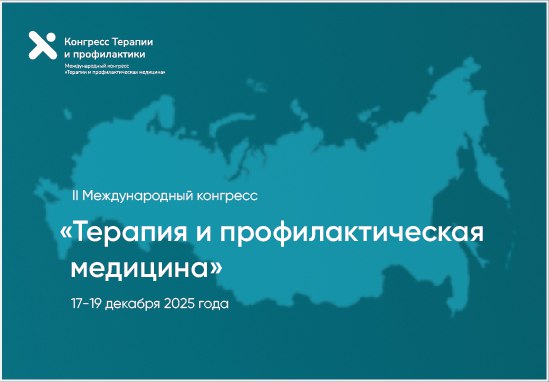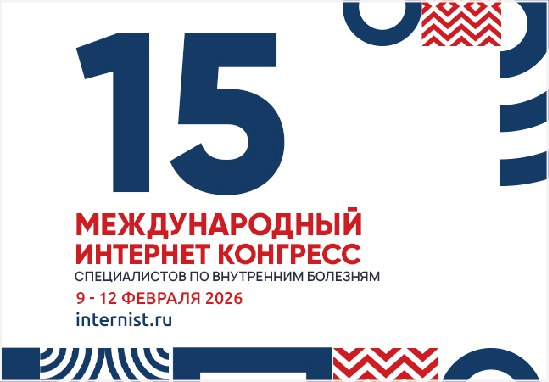Омега-3 полиненасыщенные жирные кислоты в кардиологии
Аннотация
Длинноцепочечные ω-3 полиненасыщенные жирные кислоты (ω-3 ПНЖК) –эйкозапентаеновая кислота (ЭПК) и докозагексаеновая кислота (ДГК) обладают рядом важных биологических эффектов, которые могут быть использованы в кардиологии. Потребление длинноцепочечных ω-3 ПНЖК в дозах 3-4 г/сут. и выше приводит к снижению гипертриглицеридемии, тромбогенеза, воспалительных и иммунных процессов, тонуса сосудов. Свободные ЭПК и ДГК являются структурными компонентами клеточных мембран; они модифицируют – ингибируют функции трансмембранных ионных каналов, оказывая антиаритмогенное действие, повышая вариабельность сердечного ритма. В исследовании GISSI – Prevenzione trial у пациентов, принимающих ω-3 ПНЖК, суммарный показатель, включающий смертность от всех причин, а также несмертельные инфаркты миокарда (ИМ) и инсульты (МИ), оказался ниже, чем в группе плацебо на 15-16% (Р=0,02), а риск смерти от сердечно-сосудистых заболеваний плюс несмертельные ИМ и МИ ниже, чем в группе плацебо на 20-21% (Р=0,006). Наибольшим было уменьшение риска внезапной смерти – 45% (Р=0,0006), которое проявлялось уже через 4 месяца лечения.
Об авторе
Н. В. ПероваРоссия
Список литературы
1. Kromann N, Green A. Epidemiological studies in the Upernavic district Grenland: incidence of some chronic disease 1950-1974. Acta Med Scand 1980; 208: 401-6.
2. Dyeberg J, Band HO, Hjorne N. Fatty acid composition of the plasma lipids in Grenland Eskumos. Am Clin-Nutr 1975; 28: 958-66.
3. Leaf A, Weber PC. Cardiovascular effects of n-3 fatty acids. N Engl J Med 1988; 318(9): 549-57.
4. Tinoco J. Dietary requirements and functions of -linolenic acid in animals. Prog Lipid Res 1982; 21: 1-45.
5. Holman RT. Nutritional and metabolic interrelationships between fatty acids. Fed Proc 1964; 23: 1062-7.
6. Phillipson BE, Rothrock DW, Connor WE, et al. Reduction of plasma lipids, lipoproteins and apoproteins by dietary fish oibs in patients with hypertriglyceridemia N Engl J Med 1985; 312: 1210-6.
7. Sullivan DR, Sanders TA, Trayner IM, et al. Paradoxal elevation of LDL apoprotein B levels in hypertriglyceridaemic patients and normal subjects ingesting fish oil. Atherosclerosis 1986; 61: 129-34.
8. Harris WS. Fish oils and plasma lipid and lipoprotein metabolism in humans: a critical review. J Lipid Res 1989; 30: 785-807.
9. von Schacky C, Fischer S, Weber PC. Long term effects of dietary marine ω-3 fatty acids upon plasma and cellular lipids, platelet function, and eicosanoid formation in humans J Clin Invest 1985; 76: 1626-31.
10. Kang JX, Leaf A. Evidence that free polyunsaturated fatty acids modify Na+ channels by directly binding of the channel proteins. Proc Natl Acad Sci USA 1996; 93: 3542-6.
11. Kromhout D, Bosschieter EB, de Lezenne Coulander C. The inverse relation between fish consumption and 20-year mortality from coronary heart disease (Zutphen dietary study). N Engl J Med 1985; 312: 1205-9.
12. Knapp HR, Reily JA, Alessandrini P, et al. In vivo indexes of platelet and vascular function during fish oil administration in patients with atherosclerosis. N Engl J Med 1986; 314: 937-42.
13. Shekele RB, Missel LV, Paul O, et al. Fish consumption and mortality from coronary heart disease. N Engl J Med 1985; 313: 820-4.
14. GISSI – Prevenzione Investigrtors. Dietary Supplementation with ω-3 polyunsaturated fatty acids and vitamin E after myocardial infarction: results of the GISSI – Prevenzione trial. Lancet 1999; 384: 447-55.
15. Marchioli R, Barzi F, Bomba E, et al. Early protection against sudden death by n-3 polyunsaturated fatty acids after myocardial infarction. Circulation 2002; 105(16): 1897-902.
16. Heart Outcomes Prevention Evaluation Study Investigators. Vitamin E supplementation and cardiovascular events in high-risk patients. N Engl J Med 2000; 342: 154-60.
17. Heart Protection Study Collaborative Group. MRC/BHF Heart Protection Study of antioxidant vitamin supplementation in 20536 high-risk individuals: a randomized placebo-controlled trial. Lancet 2002; 360: 23-33.
18. Burr ML, Fehily AM, Gilbert JF, et al. Effects of changes in fat, fish, and fibre intakes on death and myocardial reinfarction: diet and reinfarction trial (DABT). Lancet 1989; 8666: 757-61.
19. Hu EB, Bronner L, Willet WC, et al. Fish and омега-3 fatty acid intake and risk of coronary heart disease in women. JAMA 2002; 287(14): 1815-21.
20. Albert CM, Campos H, Stampler MJ, et al. Blood PUFAs and the risk of sudden death N Engl J Med 2002; 346: 1113-8.
21. Siscovick DS, Raghunathan TE, King I, et al. Dietary intake and cell membrane levels of long-chain n-3-polyunsaturated fatty acids and risk of primary cardiac arrest. JAMA 1995; 274: 1363-7.
22. Priori SG, Aliot E, Blomstrom-Lundquist C, et al. Task Force on Sudden Cardiac Death of the European Society of Cardiology. Eur Heart J 2001; 22: 1374-450.
23. Rosenberg TH. Fish food to calm the heart. N Engl J Med 2002; 346: 1102-3.
24. Rupp H, Verboom C-N, Jäger B. Saving lives post MI: highly purified omega-3 PUFA for prevention of sudden death. I Clin and Basic Cardiology 2002; 5: 209-11.
25. Weylandt KH, Kang JX, Leaf A. Polyunsaturated fatty acids exert antiarrhythmic actions as free fatty acids rather then in phospholipids. Lipids 1996; 31: 977-82.
26. Рound EM, Kang JX, Leaf A. Partitioning of polyunsaturated fatty acids, which prevent cardiac arrhytmias, into phospholipid cell membrane. J Lipid Res 2001; 42: 346-51.
27. Task Force of the European Society of Cardiology the North American Society of Pacing Electrophysiology. Heart rate variability standards of measurement, physiological interpretation and clinical use. Circulation 1996; 93: 1043-65.
Рецензия
Для цитирования:
Перова Н.В. Омега-3 полиненасыщенные жирные кислоты в кардиологии. Кардиоваскулярная терапия и профилактика. 2005;4(4):101-107.
For citation:
Perova N.V. Omega-3 polyunsaturated fatty acids in cardiology. Cardiovascular Therapy and Prevention. 2005;4(4):101-107. (In Russ.)
























































